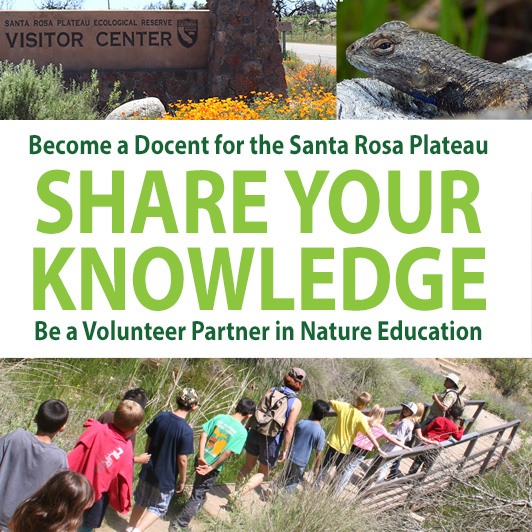About Santa Rosa Plateau
The Santa Rosa Plateau Ecological Reserve, located at the southern end of the Santa Ana Mountains in southwest Riverside County near the city of Murrieta, is a hidden gem that offers a fascinating glimpse into the history and ecosystems of the area. Consisting of 9,000 acres, the Reserve protects unique ecosystems such as Engelmann oak woodlands, riparian wetlands, coastal sage scrub, chaparral, bunchgrass prairie, and vernal pools as well as more than 200 species of native birds and 49 endangered, threatened or rare animal and plant species, including mule deer, mountain lions, badgers, bobcats, western pond turtles, white-tailed kites and fairy shrimp. Of the two species of fairy shrimp that live in the seasonal vernal pools on the Reserve, one is found only here and nowhere else on Earth!
An especially popular day-hike destination at the Reserve is the Moreno and Machado Adobes, the two oldest standing structures in Riverside County, which date back to 1846 and once served as bunkhouses for cowboys. These interesting historical buildings, shaded by a 400-year-old tree and separated by a relaxing one-of-a-kind picnic area, provide a unique opportunity to experience Riverside County’s rich history.
The Reserve offers a number of interpretive programs and trail walks. Horseback riding and mountain biking are popular activities in the Sylvan Meadows Multi-Use Area of the Plateau.
Location
39400 Clinton Keith Rd., Murrieta, CA 92562
Reserve Hours
Trails: 7 a.m. to 4:30 p.m. | No dogs allowed on trails.
Reserve Fees
$4 per adult and $3 per child
Species Habitat Ecology
The Santa Rosa Plateau Ecological Reserve protects six distinct plant communities
Oak Woodland
Coast live oak woodlands frequent low lying areas. Engelmann oak savanna can be found on elevated land where water is infrequent, as Engelmann oaks are drought deciduous. Bird species such as band-tailed pigeons, acorn woodpeckers, red-shouldered hawks, screech owls, and great horned owls utilize these two oak species.
Grassland
The native bunchgrass prairie on the Santa Rosa Plateau is considered the finest example of native grasslands remaining in California. The prairie reveals a host of native wildflowers — among them chocolate lilies, mariposa lilies, lupines, checkerblooms, shooting stars, and Johnny jump-ups. The grasslands are used by badger, mule deer, and many burrowing rodents.
Vernal Pools
Vernal pools are found on mesa tops, and support some of the rarest plant and animal species in the region – California Orcutt grass, San Diego button-celery, thread-leaf brodiaea, and fairy shrimp. During the winter months, these seasonal pools are frequented by many water fowl, including green-winged teals, Canada geese, grebes, greater yellowlegs, and long-billed dowitchers. As the water recedes in spring, brightly-colored wildflowers such as yellow goldfields and purple downingia circle the banks of the pools with bright color.
Chaparral
The most common plant community in California can be found on the Plateau in areas of granite rock outcroppings. Plant species such as chamise ceonothus and manzanita are characterized by their tough, woody stems and small leaves which help conserve water.
Coastal Sage Scrub
Gone frome 95% of its former sourthern California range, the Reserve protects examles of a plant community that is home to endangered species such as San Diego coast horned lizard and California gnatcatcher.
Riparian Wetland
Low-lying areas where gravity accumulates water support dense stands of vegetation including western sycamore, arroyo willow and poison oak. Pools along these stream coarses called tenajas (ten-ah-has) allow western pond turtles, California newts and red-legged frogs to survive through dry summer months.
The Santa Rosa Plateau Ecological Reserve, located at the southern end of the Santa Ana Mountains in southwest Riverside County near the city of Murrieta, is a hidden gem that offers a fascinating glimpse into the history and ecosystems of the area.
Become a Docent with Santa Rosa Plateau for our Outdoor Education Programs!
Consisting of 9,000 acres, the Reserve protects unique ecosystems such as Engelmann oak woodlands, riparian wetlands, coastal sage scrub, chaparral, bunchgrass prairie, and vernal pools as well as more than 200 species of native birds and 49 endangered, threatened or rare animal and plant species, including mule deer, mountain lions, badgers, bobcats, western pond turtles, white-tailed kites and fairy shrimp. Of the two species of fairy shrimp that live in the seasonal vernal pools on the Reserve, one is found only here and nowhere else on Earth!
An especially popular day-hike destination at the Reserve is the Moreno and Machado Adobes, the two oldest standing structures in Riverside County, which date back to 1846 and once served as bunkhouses for cowboys. These interesting historical buildings, shaded by a 400-year-old tree and separated by a relaxing one-of-a-kind picnic area, provide a unique opportunity to experience Riverside County's rich history.
The Reserve offers a number of interpretive programs and trail walks. Horseback riding and mountain biking are popular activities in the Sylvan Meadows Multi-Use Area of the Plateau.













